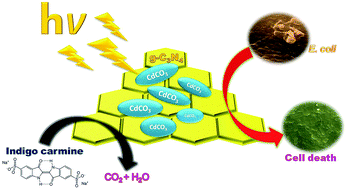当前位置:
X-MOL 学术
›
New J. Chem.
›
论文详情
Our official English website, www.x-mol.net, welcomes your feedback! (Note: you will need to create a separate account there.)
Microwave assisted in situ decoration of a g-C3N4 surface with CdCO3 nanoparticles for visible light driven photocatalysis†
New Journal of Chemistry ( IF 3.3 ) Pub Date : 2018-03-16 00:00:00 , DOI: 10.1039/c8nj00444g Devthade Vidyasagar 1, 2, 3, 4, 5 , Sachin G. Ghugal 5, 6, 7, 8, 9 , Aditi Kulkarni 4, 5, 10 , Ashok G. Shende 1, 2, 3, 4, 5 , Suresh S. Umare 1, 2, 3, 4, 5 , Rajamma Sasikala 5, 11, 12, 13
New Journal of Chemistry ( IF 3.3 ) Pub Date : 2018-03-16 00:00:00 , DOI: 10.1039/c8nj00444g Devthade Vidyasagar 1, 2, 3, 4, 5 , Sachin G. Ghugal 5, 6, 7, 8, 9 , Aditi Kulkarni 4, 5, 10 , Ashok G. Shende 1, 2, 3, 4, 5 , Suresh S. Umare 1, 2, 3, 4, 5 , Rajamma Sasikala 5, 11, 12, 13
Affiliation

|
Graphitic carbon nitride (g-C3N4) supported cadmium carbonate (CdCO3) as an organic–inorganic hybrid nanophotocatalyst was realised by an in situ microwave heating method. The hybrid composite retains the structure of each component, which was verified by p-XRD, FT-IR and solid state 13C-NMR analysis. The as-prepared hybrid g-C3N4/CdCO3 composites were evaluated as a photocatalyst towards the degradation of indigo carmine (IC) dye and inactivation of the Gram negative E. coli pathogen. In this composite, the wide band gap CdCO3 acts as an electron accepting platform from g-C3N4 and facilitates the subsequent photocatalytic reaction. The optimized hybrid g-C3N4/CdCO3-90 photocatalyst exhibits four-fold increase in the degradation of IC dye compared to pristine g-C3N4 and almost a complete mineralization of the dye occurs after 180 min of irradiation. Besides, this photocatalyst completely inhibits the growth of E. coli bacteria within 45 min of visible light irradiation. The enrichment in the photoactivity of CdCO3 decorated g-C3N4 is ascribed to the combined effects of improved visible light absorption, enhanced dye adsorption and facile separation of electron–hole pairs as evidenced by electrochemical impedance spectroscopy (EIS) measurements. The present work may provide valuable information and insights into the microwave assisted synthesis of g-C3N4 hybrid composites and may permit a better comprehension of future advancements in high performance materials for environmental remediation applications.
中文翻译:

微波辅助用CdCO 3纳米粒子对gC 3 N 4表面进行原位装饰,用于可见光驱动的光催化†
通过原位微波加热方法实现了石墨化氮化碳(gC 3 N 4)负载的碳酸镉(CdCO 3)作为有机-无机杂化纳米光催化剂。杂化复合材料保留了每种组分的结构,这已通过p-XRD,FT-IR和固态13 C-NMR分析得到了验证。评价了所制备的杂化gC 3 N 4 / CdCO 3复合材料作为光催化剂对靛蓝胭脂红(IC)染料的降解和革兰氏阴性大肠杆菌病原体的灭活的作用。在该复合材料中,宽带隙CdCO 3充当了gC的电子接受平台3 N 4并促进随后的光催化反应。与原始gC 3 N 4相比,优化的杂化gC 3 N 4 / CdCO 3 -90光催化剂在IC染料的降解中表现出四倍的增加,并且在照射180分钟后几乎完全发生了矿化。此外,这种光催化剂在可见光照射后的45分钟内完全抑制了大肠杆菌的生长。CdCO 3装饰的gC 3 N 4的光活性富集归因于改善的可见光吸收,增强的染料吸附和电子-空穴对的轻松分离的综合效果,如电化学阻抗谱(EIS)测量所证明的。本工作可以为gC 3 N 4杂化复合材料的微波辅助合成提供有价值的信息和见识,并且可以更好地理解用于环境修复应用的高性能材料的未来发展。
更新日期:2018-03-16
中文翻译:

微波辅助用CdCO 3纳米粒子对gC 3 N 4表面进行原位装饰,用于可见光驱动的光催化†
通过原位微波加热方法实现了石墨化氮化碳(gC 3 N 4)负载的碳酸镉(CdCO 3)作为有机-无机杂化纳米光催化剂。杂化复合材料保留了每种组分的结构,这已通过p-XRD,FT-IR和固态13 C-NMR分析得到了验证。评价了所制备的杂化gC 3 N 4 / CdCO 3复合材料作为光催化剂对靛蓝胭脂红(IC)染料的降解和革兰氏阴性大肠杆菌病原体的灭活的作用。在该复合材料中,宽带隙CdCO 3充当了gC的电子接受平台3 N 4并促进随后的光催化反应。与原始gC 3 N 4相比,优化的杂化gC 3 N 4 / CdCO 3 -90光催化剂在IC染料的降解中表现出四倍的增加,并且在照射180分钟后几乎完全发生了矿化。此外,这种光催化剂在可见光照射后的45分钟内完全抑制了大肠杆菌的生长。CdCO 3装饰的gC 3 N 4的光活性富集归因于改善的可见光吸收,增强的染料吸附和电子-空穴对的轻松分离的综合效果,如电化学阻抗谱(EIS)测量所证明的。本工作可以为gC 3 N 4杂化复合材料的微波辅助合成提供有价值的信息和见识,并且可以更好地理解用于环境修复应用的高性能材料的未来发展。



























 京公网安备 11010802027423号
京公网安备 11010802027423号